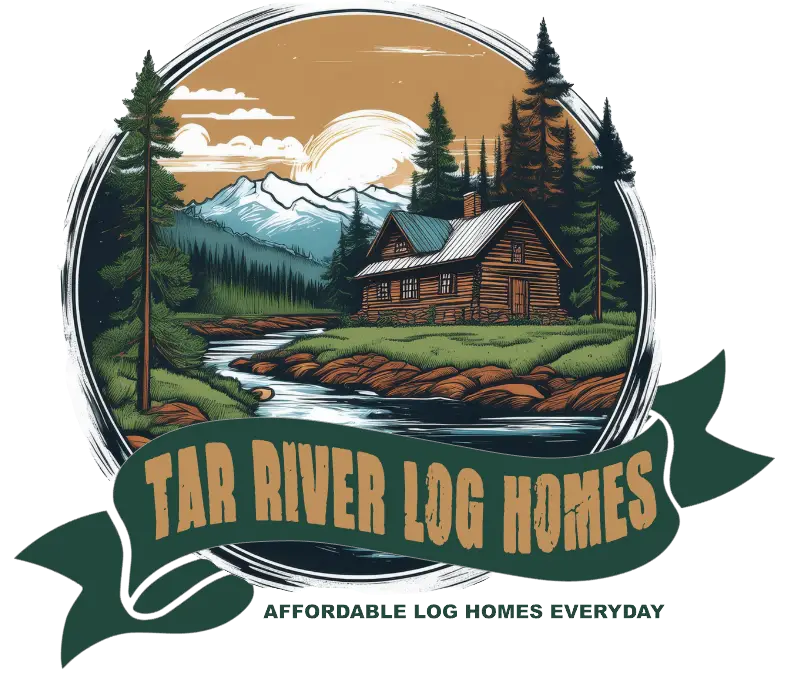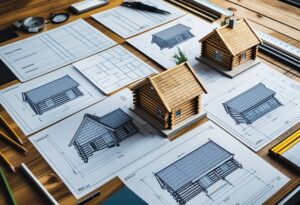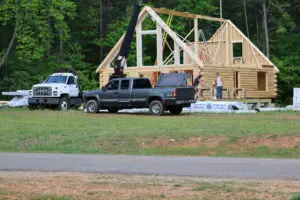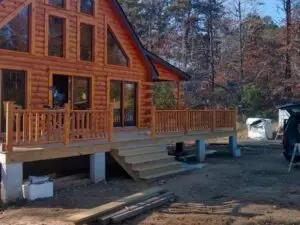Choosing a floor plan starts with how you live day to day. The right layout supports family time and privacy. Open spaces, smart storage, and good light make cabins feel larger and brighter.
Modern plans blend classic log charm with today’s comfort and efficiency. At Tar River Log Homes, we value clear choices that fit real budgets and real families.
In this guide, you’ll see practical options to plan a cozy, efficient log cabin.
Popular Log Cabin Floor Plan Options
Log cabin floor plans offer a variety of layouts that can suit your lifestyle and space needs. You’ll find options focused on maximizing open living areas, maintaining traditional rustic charm, incorporating modern features, or expanding vertically with multi-level designs.
Open Concept Designs
Open concept floor plans are popular for creating a spacious feel in your log cabin. These layouts usually combine the kitchen, dining, and living areas into one large, connected space.
This design encourages social interaction and allows natural light to flow easily through the main gathering areas. You’ll often find large windows or sliding doors in open concept cabins, enhancing your view of the outdoors.
This style is ideal if you enjoy entertaining guests or want a bright, airy home. Compact or medium-sized cabins often use this plan to maximize space efficiently.
Traditional Log Cabin Layouts
Traditional log cabin layouts typically feature a more segmented design with distinct rooms for cooking, dining, and sleeping. You might find cozy bedrooms and a compact kitchen tucked away from a central living room with a fireplace as the focal point.
These plans emphasize rustic details, such as exposed log walls and handcrafted wood elements, to keep the countryside or mountain vibe authentic. They can include porches or wrap-around decks that extend your living space outdoors.
This style works well if you want that classic cabin feel with clearly defined rooms.
Modern Floor Plan Styles
Modern log cabin floor plans combine traditional log construction with contemporary design elements. You could see sleek, minimalist interiors, flat or low-pitched roofs, and open layouts optimized for energy efficiency.
Many plans include smart storage solutions and multipurpose rooms. These designs often feature large, energy-efficient windows and updated materials that blend rustic charm with comfort and convenience.
You’ll find features like gourmet kitchens or spa-like bathrooms included. This style fits well if you want a stylish but practical cabin with modern amenities.
Multi-Level Floor Plans
Multi-level log cabin plans utilize vertical space to offer more room without increasing the cabin’s footprint. You may find two or three-story designs with bedrooms or loft areas upstairs and living spaces below.
These plans often include separate zones for privacy, such as master suites on one level and guest rooms on another. Stairs, balconies, and mezzanines add architectural interest.
Multi-level cabins work great when you need extra bedrooms or want dedicated work and living areas within your cabin.
Choosing the Right Floor Plan for Your Needs
When selecting a log cabin floor plan, focus on how well it fits your daily life and long-term goals. Think about who will live there, the kind of activities you’ll host, and any special needs for comfort or mobility.
Family Size Considerations
Your household size directly affects the number of bedrooms and bathrooms you’ll need. For a couple or solo occupant, a smaller plan with one or two bedrooms might work well.
Families typically require more private rooms and multiple bathrooms to avoid crowding. You should also think about future plans, such as having guests or growing your family.
Spaces like flexible rooms that can convert to bedrooms or offices add value. Open living areas can provide common space without making things feel cramped.
Entertaining and Gathering Spaces
If you enjoy hosting, your plan should include a spacious kitchen and living area that allows easy movement and socializing. An open floor concept where the kitchen, dining, and living room flow together creates a natural hub.
Consider adding a large dining table or an island with seating. Outdoor spaces, like a covered porch or deck, can extend your entertaining options, especially in pleasant weather. Storage for extra chairs or party supplies also helps keep gatherings smooth.
Accessibility Features
Planning for accessibility means designing with ease of movement in mind. Single-story layouts eliminate stairs, making your home more comfortable as you age or if mobility challenges arise.
Wider doorways and hallways improve wheelchair access. Features like lever handles, step-free entrances, and accessible bathrooms with grab bars can greatly enhance daily living. Even if you don’t need these modifications now, including them in your plan can save costly renovations later.
Room and Space Customization Ideas
You can tailor your log cabin’s rooms to suit how you live and what you need most. Whether you want adaptable sleeping arrangements, productive work areas, or extra cozy spaces, there are ways to make each part of your cabin work better for you.
Flexible Bedrooms
Having bedrooms that serve multiple purposes can improve how you use your cabin’s space. Consider using Murphy beds or convertible sofas that open up living areas when not in use.
Adding built-in storage like under-bed drawers or closets with adjustable shelving helps keep things organized. You might want a guest bedroom that doubles as a hobby room or a nursery that easily transitions into a child’s room.
If space is tight, sliding or pocket doors save room without sacrificing privacy. Choosing light colors and windows near beds can create a fresh, open feel even in compact bedrooms.
Home Office and Workspaces
More people work from home, so including a functional office space in your log cabin is smart. Find a quiet corner with good natural light and enough room for a desk, chair, and storage.
Built-in shelves or cabinets can help avoid clutter. You might want to use a desk that folds away or a multi-purpose table to save space.
Consider soundproofing with thicker walls or window treatments if the cabin is shared. You can also design your workspace near a window for better views and reduced eye strain.
Loft Areas
Lofts add valuable square footage without expanding the cabin’s footprint. Use lofts for sleeping areas, reading nooks, or playrooms while keeping the main floor open.
Open railing or half-walls make lofts feel connected to the rest of the cabin, maintaining airflow and light. Remember to plan for easy access, like a sturdy ladder or compact staircase.
Loft ceilings are often sloped. Choosing low furniture and creative storage solutions helps maximize comfort and usability in these spaces.
Outdoor and Indoor Flow Enhancements
Creating a seamless transition between your cabin’s interior and exterior spaces can significantly enhance your daily living experience. Thoughtful design elements and well-planned outdoor structures help extend your living area and bring nature closer to your everyday life.
Large Decks and Porches
Adding a large deck or porch offers you a versatile outdoor area for relaxing, entertaining, or dining. These spaces work as a natural extension of your home, letting you enjoy fresh air without leaving the comfort of your cabin.
When planning a deck or porch, consider factors like orientation to capture sunlight and views. Using natural materials such as wood can keep the aesthetic consistent with your cabin’s rustic look.
Design your deck or porch to flow naturally from your main living area to encourage frequent use.
Indoor-Outdoor Living Integration
You can integrate indoor and outdoor living by focusing on openness and connectivity. Open floor plans with large windows or glass doors create visual links between inside and outside.
Materials matter. Flooring that continues from inside to outdoor patios, like stone or wood, supports a seamless feel.
Including elements such as wraparound porches or outdoor kitchens encourages you to move freely between the two spaces. Simple design strategies include aligning indoor and outdoor furniture styles and planning the outdoor space as an extension of rooms like the kitchen or living room.
Adding covered areas for weather protection and year-round use makes your cabin feel larger and more inviting to relax and host guests.
Energy Efficiency in Log Cabin Floor Plans
Creating an energy-efficient log cabin starts with designing smart features that reduce heat loss and optimize natural energy. Thoughtful layout choices can help control indoor temperatures, lower your energy bills, and keep your cabin comfortable through all seasons.
Passive Solar Window Placement
According to the U.S. Department of Energy, living-area windows that face within 30° of true south capture winter sun and store it in interior mass. On the other hand, roof overhangs help block summer heat. This strategy cuts heating loads without sacrificing comfort.
Window Placement Strategies
Where you place windows has a big impact on your cabin’s energy use. South-facing windows catch the most sunlight during winter, helping to warm your space naturally.
On the other hand, minimizing large windows on the north side reduces heat loss. You can also use window overhangs or awnings to block summer sun and prevent overheating.
Double or triple-pane windows with low-emissivity coatings add insulation while still letting in light. Position windows strategically to encourage cross-ventilation, helping you cool the cabin without relying on electricity.
Using window placement with the sun’s path in mind lets you take advantage of passive solar heating effectively.
Insulation Techniques
Insulation is critical to keep your log cabin airtight and comfortable. Start by sealing gaps between logs with high-quality chinking to prevent drafts.
Add rigid foam or spray foam insulation inside walls for extra thermal protection. These materials block heat transfer and help control moisture buildup, which protects your logs.
Consider insulating the roof and floor as well, since heat escapes easily through these areas. An airtight design paired with a heat recovery ventilator ensures fresh air without losing warmth.
Using energy-efficient insulation materials tailored to your climate keeps your cabin cozy and cuts down on heating and cooling costs.
Specialized Floor Plan Features
When designing your log cabin, adding functional spaces can greatly enhance daily living. Careful consideration of entryways and extra building areas can improve organization and expand usable space.
Mudrooms and Storage Solutions
Including a mudroom is a practical choice for managing dirt, shoes, and outdoor gear. A well-planned mudroom can act as a buffer between the outdoors and your living space, helping keep your cabin clean.
Look for designs with built-in benches, cubbies, and hooks. These allow you to store coats, boots, and equipment neatly.
You might also consider extra storage for seasonal items or sports gear. Incorporating storage closets or pantries near the kitchen or entryway complements your mudroom. This keeps essentials in easy reach without cluttering common areas.
Basement and Garage Additions
Adding a basement broadens your cabin’s usable area, often serving as extra living space, storage, or a workshop. Consider whether you want a full or partial basement based on your land and climate.
A garage attachment is beneficial if you want vehicle protection and additional storage. Many plans include garages with direct access to the home, enhancing convenience on rainy or snowy days.
Both basements and garages can be customized with shelving, workbenches, or even guest rooms. Think about your specific needs to decide which additions will provide the most value to your lifestyle.
Adapting Floor Plans for Unique Lifestyles
Creating a log cabin that fits your lifestyle means thinking beyond traditional layouts. You can customize key features to make your space comfortable and practical, whether you have pets or need room for extended family.
Pet-Friendly Designs
When designing for pets, focus on durable materials and easy maintenance. Consider flooring options like sealed hardwood or stone that resist scratches and are simple to clean.
You might want to include a mudroom or entry area with built-in storage for leashes, boots, and pet supplies. A dedicated pet washing station near an entrance can save time and keep the cabin cleaner.
Open floor plans with ample natural light and outdoor access help your pets feel relaxed and engaged. Wide doorways and screens on porch doors also make it easier to move pets in and out safely.
Trusted teams are dedicated to helping regular families build their dream cabins with affordability and quality in mind.
Multi-Generational Living Spaces
If your cabin will host multiple generations, plan for a mix of private and shared areas to balance togetherness and personal space. Separate bedrooms and bathrooms are essential for comfort.
Adding a small kitchenette or extra dining area on one side of the home helps create semi-independent living zones. You can design flexible rooms that serve as offices, guest rooms, or hobby spaces, depending on needs.
Wider hallways and doorways improve accessibility for family members with limited mobility. Thoughtful layout choices ensure everyone has enough space without feeling crowded. When choosing your log cabin floor plan, start by thinking about how you live day-to-day.
Your plan should match your lifestyle, not just look good on paper. Consider how many bedrooms and bathrooms you need. Think about the flow between spaces like the kitchen, living room, and bedrooms.
Here are some quick tips:
- Prioritize functionality over extravagance.
- Picture how natural light will enter your home.
- Don’t forget about storage and utility spaces.
Keep in mind your budget and the size of the land where you’ll build. Larger floor plans might look appealing, but could be more expensive and harder to maintain. Customizing your plan can help.
Modifying a standard design allows you to create a cabin that fits your personality and practical needs without starting from scratch. If you plan to use your cabin seasonally, think about insulation and energy efficiency. These factors affect comfort and running costs.
Review multiple floor plan options side by side. Create a simple table or checklist to compare features like square footage, room counts, and special amenities.
Choosing a Floor Plan That Fits Real Life
The best log cabin floor plan supports your daily rhythms—bright shared spaces, right-sized bedrooms, smart storage, and porches that extend living outdoors. A few sourced design moves—solar-smart windows, universal access, and good drainage—pay off for decades.
Tar River Log Homes is here to keep things simple and affordable so your cabin feels welcoming from day one.
Ready to map your layout? Browse family-friendly plans, compare options side by side, and get a no-pressure quote to bring your cozy, practical cabin to life.
Frequently Asked Questions
When choosing a log cabin floor plan, you’ll find options that focus on space efficiency, simplicity, and modern touches. Some plans include lofts for extra room, while others keep the design straightforward and compact. Pricing can vary widely depending on size and custom features.
What are some cozy small log cabin floor plans?
You can find floor plans designed around one or two bedrooms, typically ranging from 400 to 900 square feet. These layouts make the most of limited space while providing cozy living, often featuring an open living and kitchen area.
Where can I find log cabin floor plans with a simple design?
Look for basic rectangular or square designs with minimal interior walls. These focus on functionality and ease of construction, keeping costs and complexity low. Tar River Log Homes offers starter log cabin blueprints that fit this style.
Can you suggest log cabin plans that include a loft?
Loft plans are popular for adding sleeping or storage space without increasing the building footprint. Common in cabins under 1,200 square feet, lofts provide a cozy retreat and better use of vertical space.
How can I find modern log cabin floor plans?
Modern log cabins often mix traditional logs with contemporary layouts and large windows. Search for plans that include open floor concepts, clean lines, and sometimes hybrid materials alongside logs for a current feel.
Are there log cabin designs under 2,000 square feet available?
Yes, many plans fall under 2,000 square feet, ranging from compact weekend retreats to full-time homes. These typically balance comfort and efficiency, offering multiple bedrooms and living spaces without excessive size. Tar River Log Homes is here to help you find the right plan for your needs.
Where can I see log home floor plans along with their prices?
Many log home plan websites provide pricing details based on square footage and customization options. Prices for custom log cabins can range from $350 up to $700 per square foot, depending on location and materials.
At Tar River Log Homes, we believe in offering straightforward pricing and high-quality options for every budget. You can explore a variety of floor plans and transparent prices designed to help regular families build their dream log home.




